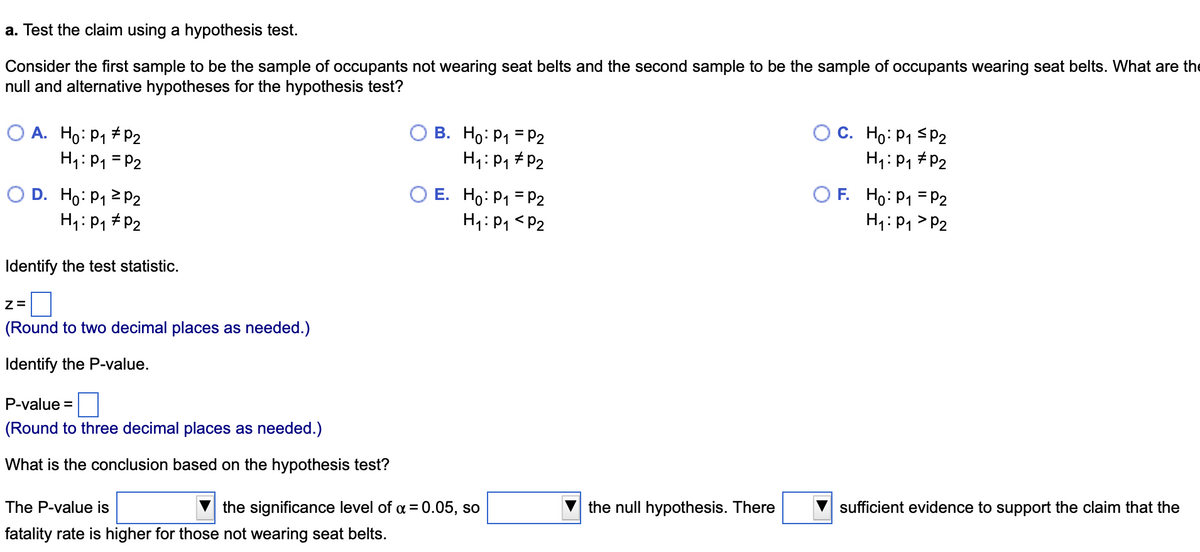A simple random sample of front-seat occupants involved in car crashes is obtained. Among 2769 occupants not wearing seat belts, 29 were killed. Among 7873 occupants wearing seat belts, 11 were killed. Use a 0.05 significance level to test the claim that seat belts are effective in reducing fatalities. Complete parts (a) through(c) below.
A simple random sample of front-seat occupants involved in car crashes is obtained. Among 2769 occupants not wearing seat belts, 29 were killed. Among 7873 occupants wearing seat belts, 11 were killed. Use a 0.05 significance level to test the claim that seat belts are effective in reducing fatalities. Complete parts (a) through(c) below.
Algebra & Trigonometry with Analytic Geometry
13th Edition
ISBN:9781133382119
Author:Swokowski
Publisher:Swokowski
Chapter10: Sequences, Series, And Probability
Section10.8: Probability
Problem 29E
Related questions
Question
A simple random sample of front-seat occupants involved in car crashes is obtained. Among
2769 occupants not wearing seat belts, 29 were killed. Among 7873 occupants wearing seat belts,
11 were killed. Use a 0.05 significance level to test the claim that seat belts are effective in reducing fatalities. Complete parts (a) through(c) below.

Transcribed Image Text:a. Test the claim using a hypothesis test.
Consider the first sample to be the sample of occupants not wearing seat belts and the second sample to be the sample of occupants wearing seat belts. What are the
null and alternative hypotheses for the hypothesis test?
O A. Ho: P₁ P2
H₁: P₁ = P2
D. Ho: P₁ P2
H₁: P₁ P2
Identify the test statistic.
Z=
(Round to two decimal places as needed.)
Identify the P-value.
P-value =
(Round to three decimal places as needed.)
What is the conclusion based on the hypothesis test?
B. Ho: P₁ = P2
H₁: P₁ P2
OE. Ho: P₁
H₁: P₁
The P-value is
the significance level of α = 0.05, so
fatality rate is higher for those not wearing seat belts.
P2
P2
the null hypothesis. There
C. Ho: P₁ P2
H₁: P₁
P2
OF. Ho: P₁
P2
H₁: P₁ P2
sufficient evidence to support the claim that the

Transcribed Image Text:b. Test the claim by constructing an appropriate confidence interval.
The appropriate confidence interval is
(Round to three decimal places as needed.)
What is the conclusion based on the confidence interval?
Because the confidence interval limits
(P₁-P₂)<
0, it appears that the two fatality rates are
values, it appears that the fatality rate is
c. What do the results suggest about the effectiveness of seat belts?
for those not wearing seat belts.
Because the confidence interval limits include
O A. The results suggest that the use of seat belts is associated with higher fatality rates than not using seat belts.
B. The results suggest that the use of seat belts is associated with the same fatality rates as not using seat belts.
C. The results suggest that the use of seat belts is associated with lower fatality rates than not using seat belts.
D. The results are inconclusive.
Expert Solution
This question has been solved!
Explore an expertly crafted, step-by-step solution for a thorough understanding of key concepts.
Step by step
Solved in 2 steps with 2 images

Recommended textbooks for you

Algebra & Trigonometry with Analytic Geometry
Algebra
ISBN:
9781133382119
Author:
Swokowski
Publisher:
Cengage

Algebra & Trigonometry with Analytic Geometry
Algebra
ISBN:
9781133382119
Author:
Swokowski
Publisher:
Cengage